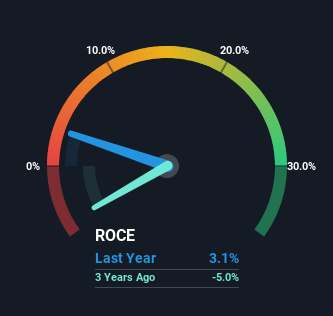- United Kingdom
- /
- Semiconductors
- /
- AIM:ENSI
Here's What's Concerning About EnSilica's (LON:ENSI) Returns On Capital
If we want to find a stock that could multiply over the long term, what are the underlying trends we should look for? Ideally, a business will show two trends; firstly a growing return on capital employed (ROCE) and secondly, an increasing amount of capital employed. This shows us that it's a compounding machine, able to continually reinvest its earnings back into the business and generate higher returns. Although, when we looked at EnSilica (LON:ENSI), it didn't seem to tick all of these boxes.
Return On Capital Employed (ROCE): What Is It?
For those who don't know, ROCE is a measure of a company's yearly pre-tax profit (its return), relative to the capital employed in the business. Analysts use this formula to calculate it for EnSilica:
Return on Capital Employed = Earnings Before Interest and Tax (EBIT) ÷ (Total Assets - Current Liabilities)
0.031 = UK£872k ÷ (UK£37m - UK£9.0m) (Based on the trailing twelve months to May 2024).
Thus, EnSilica has an ROCE of 3.1%. In absolute terms, that's a low return and it also under-performs the Semiconductor industry average of 12%.
View our latest analysis for EnSilica

In the above chart we have measured EnSilica's prior ROCE against its prior performance, but the future is arguably more important. If you're interested, you can view the analysts predictions in our free analyst report for EnSilica .
What The Trend Of ROCE Can Tell Us
The trend of ROCE doesn't look fantastic because it's fallen from 12% five years ago, while the business's capital employed increased by 444%. That being said, EnSilica raised some capital prior to their latest results being released, so that could partly explain the increase in capital employed. The funds raised likely haven't been put to work yet so it's worth watching what happens in the future with EnSilica's earnings and if they change as a result from the capital raise. Additionally, we found that EnSilica's most recent EBIT figure is around the same as the prior year, so we'd attribute the drop in ROCE mostly to the capital raise.
The Key Takeaway
While returns have fallen for EnSilica in recent times, we're encouraged to see that sales are growing and that the business is reinvesting in its operations. However, despite the promising trends, the stock has fallen 35% over the last year, so there might be an opportunity here for astute investors. So we think it'd be worthwhile to look further into this stock given the trends look encouraging.
On a separate note, we've found 3 warning signs for EnSilica you'll probably want to know about.
While EnSilica isn't earning the highest return, check out this free list of companies that are earning high returns on equity with solid balance sheets.
Valuation is complex, but we're here to simplify it.
Discover if EnSilica might be undervalued or overvalued with our detailed analysis, featuring fair value estimates, potential risks, dividends, insider trades, and its financial condition.
Access Free AnalysisHave feedback on this article? Concerned about the content? Get in touch with us directly. Alternatively, email editorial-team (at) simplywallst.com.
This article by Simply Wall St is general in nature. We provide commentary based on historical data and analyst forecasts only using an unbiased methodology and our articles are not intended to be financial advice. It does not constitute a recommendation to buy or sell any stock, and does not take account of your objectives, or your financial situation. We aim to bring you long-term focused analysis driven by fundamental data. Note that our analysis may not factor in the latest price-sensitive company announcements or qualitative material. Simply Wall St has no position in any stocks mentioned.
About AIM:ENSI
EnSilica
Designs and supplies designs and supplies complex mixed signal application specific integrated circuit chips in the United Kingdom, Rest of Europe, and internationally.
Adequate balance sheet with low risk.
Market Insights
Community Narratives



